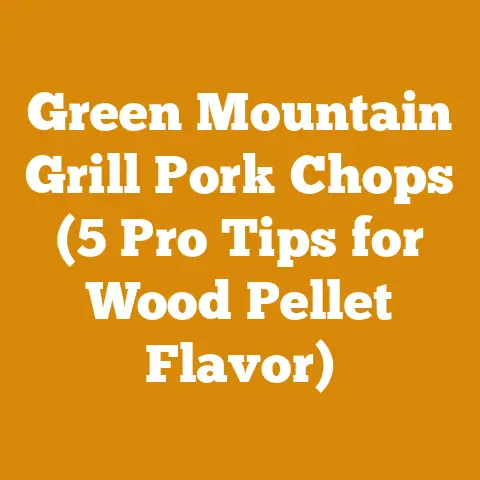Can I Burn Pressure Treated Lumber? (Toxic Risks & Safe Disposal)
I still remember the acrid smell that stung my nostrils that day. I was just a kid, helping my grandpa clear some old fencing on the farm. We had a roaring bonfire going, fueled by fallen branches and scrap lumber. Without thinking, I tossed a few pieces of what looked like regular wood onto the flames. Grandpa immediately yelled, “Hold up there, son! What’d you just throw on the fire?” He recognized it instantly – pressure-treated lumber. That was my first, and most memorable, lesson on why you absolutely, positively, cannot burn pressure-treated wood. The smell alone was enough to convince me, but the potential health and environmental risks are even more compelling reasons to avoid this dangerous practice.
Can I Burn Pressure Treated Lumber? (Toxic Risks & Safe Disposal)
The short answer, and I want to be absolutely clear: No, you cannot burn pressure-treated lumber. Burning pressure-treated wood releases highly toxic chemicals into the air and leaves behind contaminated ash. It’s illegal in many places, and more importantly, it’s a serious health hazard. But let’s dig into the why behind that statement, exploring the science, the dangers, and the responsible alternatives.
Understanding Pressure Treatment: What’s in That Wood?
Pressure treating is a process that forces chemical preservatives deep into the wood fibers, making the lumber resistant to rot, decay, and insect infestation. This process dramatically extends the lifespan of wood used in outdoor applications like decks, fences, and landscaping. However, the chemicals used are what make burning it so dangerous.
- Chromated Copper Arsenate (CCA): This was the dominant treatment for decades. As the name suggests, CCA contains chromium, copper, and arsenic. Yes, that arsenic. While CCA is no longer used in residential applications (it was phased out in 2003), you might still encounter older CCA-treated wood. Burning CCA releases arsenic into the air as a toxic gas and leaves it concentrated in the ash. Arsenic is a known carcinogen, and even short-term exposure can cause serious health problems.
- Alkaline Copper Quaternary (ACQ): This is one of the most common replacements for CCA. ACQ uses copper and quaternary ammonium compounds. While considered less toxic than CCA, burning ACQ still releases harmful chemicals, including copper oxides and ammonia. These can cause respiratory irritation and other health problems.
- Copper Azole (CA): Similar to ACQ, CA uses copper and azole fungicides. Again, burning CA releases copper oxides and other potentially harmful compounds.
- Borates: Borate-treated wood is often used for interior applications and is considered less toxic than other types of treated wood. However, burning borate-treated wood still releases boric acid, which can irritate the respiratory system.
Key Takeaway: Regardless of the specific chemicals used, pressure-treated wood contains substances that are harmful when inhaled or ingested. Burning it transforms these substances into toxic gases and concentrates them in the ash.
The Toxic Risks of Burning Pressure Treated Lumber
Burning pressure-treated wood isn’t just a bad idea; it’s a dangerous one. Here’s a breakdown of the risks:
- Inhalation of Toxic Gases: When pressure-treated wood burns, the chemicals are released as gases and particulate matter. Inhaling these gases can cause a range of health problems, including:
- Respiratory irritation: Coughing, wheezing, shortness of breath, and asthma exacerbation.
- Nausea and vomiting: Especially with arsenic exposure.
- Headaches and dizziness: Common symptoms of exposure to various toxic fumes.
- Long-term health effects: Increased risk of cancer (especially lung and skin cancer from arsenic), neurological damage, and developmental problems.
- Contaminated Ash: The ash from burning pressure-treated wood is highly concentrated with the chemicals from the treatment process. This ash can contaminate soil, water, and even surfaces inside your home if it’s tracked in.
- Soil contamination: Prevents plant growth and can leach into groundwater.
- Water contamination: Poses a risk to drinking water sources and aquatic life.
- Skin contact: Can cause skin irritation, burns, and absorption of toxic chemicals.
- Ingestion: Especially dangerous for children and pets, leading to serious health problems. I remember my neighbor’s dog getting into some old bonfire ash and getting violently ill – a stark reminder of how dangerous this can be.
- Environmental Damage: The toxic chemicals released from burning pressure-treated wood can harm the environment in several ways:
- Air pollution: Contributes to smog and respiratory problems in the community.
- Soil and water contamination: Damages ecosystems and threatens wildlife.
- Bioaccumulation: Toxic chemicals can accumulate in the food chain, affecting animals at higher trophic levels.
Data Point: Studies have shown that burning CCA-treated wood can release arsenic concentrations in the smoke that are hundreds of times higher than safe levels. Even burning relatively small amounts can create a significant health hazard.
Legal Ramifications: Is Burning Pressure Treated Wood Illegal?
In many jurisdictions, burning pressure-treated wood is illegal. The laws vary depending on your location, but they are generally based on environmental regulations and public health concerns.
- EPA Regulations: The Environmental Protection Agency (EPA) regulates the use and disposal of pressure-treated wood. While the EPA doesn’t have a blanket ban on burning all treated wood, they strongly discourage it and regulate the disposal of ash from industrial wood-burning facilities.
- State and Local Laws: Many states and local municipalities have specific laws prohibiting the burning of pressure-treated wood. These laws often carry fines and other penalties for violations. I once worked on a project where a contractor unknowingly burned some treated lumber, and he faced a hefty fine from the local environmental agency.
- Open Burning Bans: Many areas have open burning bans in place, especially during dry seasons, to prevent wildfires. These bans often include restrictions on burning any type of construction debris, including pressure-treated wood.
Actionable Takeaway: Before burning any wood, check your local regulations to ensure it’s allowed. If you’re unsure whether wood is pressure-treated, err on the side of caution and dispose of it properly.
Identifying Pressure Treated Lumber: How to Tell the Difference
Knowing how to identify pressure-treated lumber is crucial for avoiding accidental burning. Here are some key indicators:
- Color: Pressure-treated lumber often has a greenish or brownish tint due to the chemicals used in the treatment process. However, the color can fade over time, especially with exposure to sunlight. Newer ACQ-treated lumber can have a darker brown color.
- Stamps and Labels: Pressure-treated lumber is usually stamped with information about the treatment type, the treating company, and the intended use. Look for stamps that include abbreviations like CCA, ACQ, CA, or borate. These stamps are usually located on the end of the board.
- End Tags: Some pressure-treated lumber comes with end tags that provide information about the treatment and proper disposal. These tags are often brightly colored and easy to spot.
- Odor: Freshly treated lumber may have a chemical odor, although this can dissipate over time.
- Application: Consider where the lumber was used. If it was used for outdoor projects like decks, fences, or landscaping, it’s likely to be pressure-treated.
Case Study: I was helping a friend dismantle an old deck, and we came across some lumber that had clearly been treated with CCA. Even though the wood was decades old, the greenish tint was still visible, and the stamp was still legible. We carefully removed the lumber and disposed of it properly, avoiding any risk of burning it.
Safe Disposal Methods for Pressure Treated Lumber
Since you can’t burn pressure-treated wood, proper disposal is essential. Here are the recommended methods:
- Landfills: The most common way to dispose of pressure-treated lumber is to take it to a permitted landfill that accepts construction and demolition debris. Landfills are designed to contain hazardous materials and prevent them from contaminating the environment.
- Recycling (Limited): Some facilities specialize in recycling pressure-treated wood. These facilities typically grind the wood into mulch or other products. However, recycling options are limited, and it’s important to ensure that the facility is properly permitted and uses safe handling practices.
- Donation/Reuse (with Caution): If the lumber is still in good condition, you might be able to donate it to a construction project or reuse it for a non-structural application where it won’t come into direct contact with people or food. However, be sure to clearly label the lumber as pressure-treated and inform the recipient of the potential hazards. Never reuse treated wood for raised garden beds or other applications where it could contaminate food crops.
Data Point: Landfills that accept construction and demolition debris are required to meet specific environmental standards to prevent groundwater contamination. This makes them a safer option than burning or illegally dumping pressure-treated wood.
Alternatives to Burning: Responsible Wood Waste Management
Burning pressure-treated lumber is never a good option. Instead, focus on responsible wood waste management practices:
- Reduce: Minimize the amount of wood waste you generate in the first place by carefully planning your projects and using materials efficiently.
- Reuse: Find ways to reuse wood scraps for other projects or applications.
- Recycle: Explore recycling options for wood waste in your area.
- Proper Disposal: When disposal is necessary, follow the recommended methods for pressure-treated and untreated wood.
Practical Insight: I’ve found that keeping a designated scrap wood bin in my workshop helps me stay organized and find creative ways to reuse wood scraps. It’s amazing how many small projects can be made from leftover pieces of lumber.
The Right Way to Burn Wood: Safe and Sustainable Practices
While burning pressure-treated wood is off-limits, burning untreated wood can be a safe and sustainable way to heat your home or enjoy a campfire, provided you follow these guidelines:
- Burn Only Seasoned Wood: Seasoned wood has been dried for at least six months, reducing its moisture content. This makes it burn more efficiently and cleanly, producing less smoke and creosote. I always tell people, “If it hisses, it misses!” – meaning, if the wood is still wet and hissing when you put it on the fire, it’s not seasoned enough.
- Choose the Right Wood Species: Different wood species burn differently. Hardwoods like oak, maple, and ash burn longer and hotter than softwoods like pine and fir. However, softwoods are easier to ignite and can be used to get a fire started.
- Maintain Your Fireplace or Wood Stove: Regular cleaning and maintenance are essential for safe and efficient wood burning. Clean your chimney at least once a year to remove creosote buildup, which can cause chimney fires.
- Follow Local Regulations: Be aware of any local regulations regarding open burning or wood stove emissions.
- Use Proper Burning Techniques: Build fires properly to ensure good airflow and complete combustion. Avoid overloading your fireplace or wood stove, and never leave a fire unattended.
Data Point: Burning seasoned wood can reduce particulate matter emissions by up to 70% compared to burning green wood. This significantly improves air quality and reduces the risk of respiratory problems.
Wood Species for Burning: A Detailed Guide
Choosing the right wood species can make a big difference in the quality and efficiency of your fire. Here’s a detailed guide to some common wood species for burning:
- Hardwoods:
- Oak: A top choice for firewood, oak burns slowly and produces a lot of heat. It’s also relatively dense, so it takes longer to season.
- Maple: Another excellent firewood choice, maple burns hot and clean. It’s also easier to split than oak.
- Ash: Ash is easy to split and burns well, producing a steady flame and good heat.
- Beech: Beech is a dense hardwood that burns long and hot. It’s also relatively easy to split.
- Birch: Birch is a good firewood choice, but it burns faster than oak or maple. It also has a distinctive aroma.
- Softwoods:
- Pine: Pine is easy to ignite and burns quickly, making it a good choice for starting fires. However, it produces more smoke and creosote than hardwoods.
- Fir: Similar to pine, fir burns quickly and produces a lot of smoke.
- Spruce: Spruce is another softwood that’s easy to ignite, but it doesn’t produce as much heat as hardwoods.
Practical Insight: I like to mix hardwoods and softwoods in my firewood stack. I use softwoods to get the fire started and then add hardwoods for long-lasting heat.
The Science of Seasoning: Why Dry Wood Burns Better
Seasoning wood is the process of drying it to reduce its moisture content. This is essential for efficient and clean burning. Here’s why:
- Higher Heat Output: Dry wood burns hotter because less energy is required to evaporate the water in the wood.
- Less Smoke: Dry wood produces less smoke because the volatile compounds in the wood are more completely combusted.
- Less Creosote: Dry wood produces less creosote, reducing the risk of chimney fires.
- Easier Ignition: Dry wood is easier to ignite and burns more consistently.
Data Point: Freshly cut wood can have a moisture content of 50% or higher. Seasoned wood should have a moisture content of 20% or less.
Actionable Takeaway: To season wood properly, split it, stack it loosely in a sunny, well-ventilated area, and cover the top to protect it from rain and snow. Allow it to dry for at least six months, or preferably a year. Use a moisture meter to check the moisture content before burning.
Tool Selection: Essential Tools for Safe and Efficient Wood Processing
Having the right tools can make wood processing safer, easier, and more efficient. Here are some essential tools for firewood preparation:
- Chainsaw: A chainsaw is essential for felling trees and cutting logs into smaller pieces. Choose a chainsaw that’s appropriate for the size of the trees you’ll be cutting and make sure you’re properly trained in its safe operation. I always recommend investing in a quality chainsaw with safety features like a chain brake and anti-vibration system.
- Splitting Axe or Maul: A splitting axe or maul is used to split logs into firewood. Choose a tool that’s the right weight and size for your strength and experience. I prefer a maul for larger, tougher logs, and an axe for smaller, easier-to-split pieces.
- Wedges: Wedges can be used to split logs that are too difficult to split with an axe or maul alone.
- Sledgehammer: A sledgehammer can be used to drive wedges into logs.
- Log Splitter: A log splitter is a powered machine that splits logs with hydraulic pressure. It’s a great option for processing large quantities of firewood.
- Safety Gear: Always wear appropriate safety gear when processing wood, including:
- Safety glasses or a face shield: To protect your eyes from flying debris.
- Hearing protection: To protect your ears from the noise of the chainsaw.
- Gloves: To protect your hands from cuts and splinters.
- Steel-toed boots: To protect your feet from falling logs.
- Chainsaw chaps: To protect your legs from chainsaw injuries.
Practical Insight: I’ve learned the hard way that investing in quality safety gear is worth every penny. A chainsaw injury can be devastating, so it’s essential to take every precaution.
- Read the Manual: Before using a chainsaw, read the owner’s manual carefully and understand all the safety instructions.
- Wear Appropriate Safety Gear: As mentioned above, always wear safety glasses, hearing protection, gloves, steel-toed boots, and chainsaw chaps.
- Inspect the Chainsaw: Before each use, inspect the chainsaw to ensure that it’s in good working condition. Check the chain tension, oil level, and all safety features.
- Start the Chainsaw Safely: Start the chainsaw on the ground, with the chain brake engaged. Never drop-start a chainsaw.
- Use Proper Cutting Techniques: Use proper cutting techniques to avoid kickback, which is a sudden and violent reaction that can cause serious injury. Always keep both hands on the chainsaw and maintain a firm grip.
- Maintain a Safe Distance: Keep bystanders and pets at a safe distance from the chainsaw.
- Never Cut Above Your Head: Cutting above your head is extremely dangerous and should be avoided.
- Take Breaks: Chainsaw work can be physically demanding, so take frequent breaks to avoid fatigue.
- Sharpen the Chain Regularly: A sharp chain is safer and more efficient than a dull chain.
- Get Training: Consider taking a chainsaw safety course to learn proper techniques and safety procedures.
Data Point: According to the Consumer Product Safety Commission, chainsaws cause tens of thousands of injuries each year. Most of these injuries are preventable with proper training and safety precautions.
Project Planning: From Tree to Firewood
Planning is essential for a successful and safe wood processing project. Here’s a step-by-step guide to planning your firewood preparation:
- Assess Your Needs: Determine how much firewood you need to heat your home or for recreational use.
- Source Your Wood: Decide where you’ll get your wood. You can fell trees on your own property, purchase logs from a logging company, or collect firewood from designated areas with permission.
- Obtain Permits: Check with your local authorities to see if you need any permits for felling trees or collecting firewood.
- Plan Your Cutting and Splitting Area: Choose a safe and level area for cutting and splitting wood.
- Gather Your Tools and Safety Gear: Make sure you have all the necessary tools and safety gear before you start working.
- Develop a Cutting and Splitting Plan: Plan how you’ll cut and split the wood to maximize efficiency and minimize waste.
- Stack the Firewood: Stack the firewood in a sunny, well-ventilated area to season it properly.
- Monitor the Moisture Content: Use a moisture meter to check the moisture content of the wood before burning it.
Case Study: I once helped a friend prepare firewood for the winter, and we spent a lot of time planning the project beforehand. We assessed his needs, sourced the wood, obtained the necessary permits, and planned our cutting and splitting area. As a result, the project went smoothly and safely, and he had a full winter’s supply of seasoned firewood.
Common Mistakes to Avoid in Wood Processing
Even experienced wood processors can make mistakes. Here are some common mistakes to avoid:
- Using Dull Tools: Dull tools are less efficient and more dangerous than sharp tools.
- Overloading the Chainsaw: Overloading the chainsaw can cause it to stall or kickback.
- Cutting in Unsafe Conditions: Avoid cutting wood in wet, windy, or icy conditions.
- Not Wearing Safety Gear: Never compromise on safety gear.
- Working Alone: It’s always safer to work with a partner when processing wood.
- Not Taking Breaks: Fatigue can lead to accidents.
- Burning Pressure Treated Wood: As we’ve discussed, this is a serious health hazard.
- Burning Unseasoned Wood: Unseasoned wood burns poorly and produces a lot of smoke and creosote.
- Improper Storage: Storing firewood improperly can lead to rot and decay.
Practical Insight: I’ve learned from my own mistakes over the years, and I’m always striving to improve my wood processing techniques. Continuous learning and attention to detail are essential for safe and efficient wood processing.
Conclusion: Prioritizing Safety and Sustainability
Burning pressure-treated lumber is a practice that carries significant risks to your health, the environment, and potentially even your legal standing. By understanding the dangers and embracing responsible disposal methods, we can protect ourselves and our communities. Remember, safe and sustainable wood processing practices are essential for enjoying the benefits of wood fuel while minimizing its negative impacts. So, let’s choose to burn responsibly, protect our health, and preserve our environment for future generations. And if you’re ever unsure about a piece of wood, remember my grandpa’s lesson: when in doubt, throw it out (responsibly, of course!).






